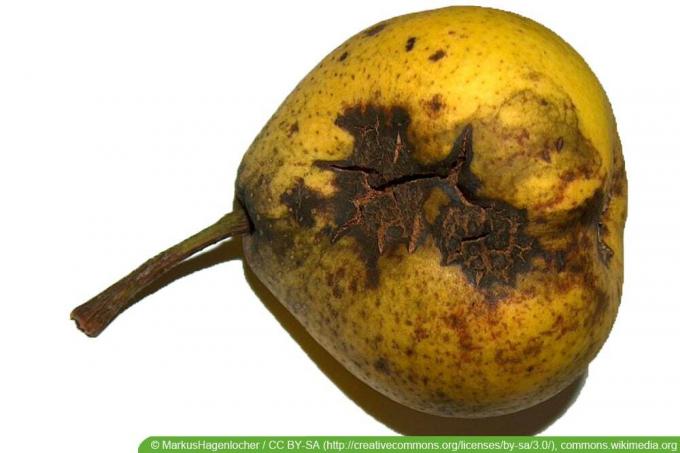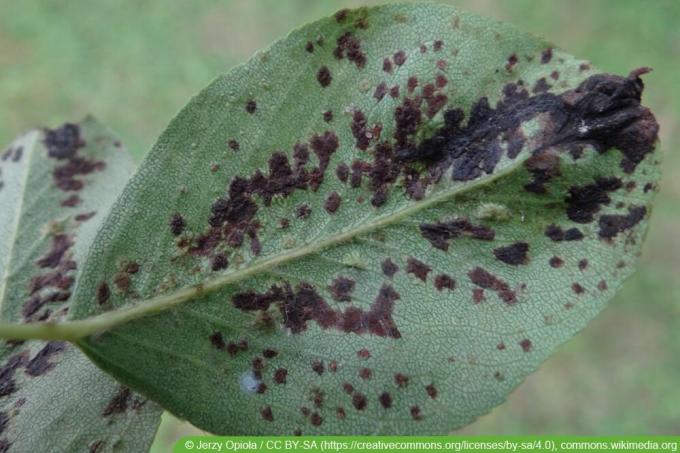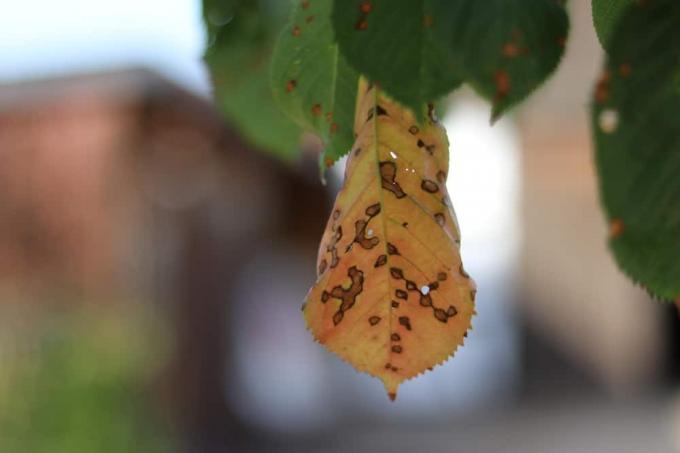

Table of contents
- How pear scab spreads
- Characteristics of scab fungus
- leaves
- fruit
- shoots
- Treat pear scab
- Notes on copper and sulfur
- prevention
Brown, cracked spots on young pear fruits indicate an infestation with the scab fungus. Similar fungal diseases can be found on apples, cherries and other types of fruit. Little infected fruits are edible, but unsightly and do not keep for long. A young tree can be damaged by a severe infestation, which is why it makes sense to fight the fungus.
How pear scab spreads
Like other fungi, pear scab forms a mycelium and reproduces using spores. Since these are very, very small and not noticeable, they can be anywhere. Especially in fallen pear leaves. The spores are carried by wind but can also be spread with plant material. The mycelium overwinters on the pear tree, mainly on the tips of the shoots. A revival of pear scab is to be feared, especially in damp weather in spring. The fungus becomes active from 15 degrees. Above 25 degrees it becomes too warm for it, which is why it does not thrive well in hot, dry summers.
A notice:
The so-called leaf wet period plays a special role. It indicates how long a leaf must be wet so that there are optimal conditions for a fungal infection. For pear scab it is 9 to 11 hours.
Characteristics of scab fungus
Signs of infection can be seen on leaves, fruits, and shoots. Usually the first symptoms appear after 2 to 3 weeks. In principle, the fungus can appear on the tree at any time as long as new shoots and leaves are formed.
leaves
Spots form, which are conspicuous in the later stage due to their dark color. They grow up to a centimeter. Severely affected leaves wither.
fruit
If the scab fungus attacks the fruit, brown or black-brown spots form. The skin tears at these points and corks. The scab fungus gets its name from the scabbed patches on the fruit. Young, severely affected fruit stun and fall from the tree immature. If fruits with scab spots reach maturity, they are edible, but are not suitable for storage due to the skin injuries. They are more susceptible to other diseases or pests.
shoots
Newly growing shoots are particularly at risk on pears. Brown or black spots form, which quickly expand and tear open the bark of the shoot. This is why the condition is called twig grind. The fungus overwinters in these shoots.
Other pear diseases with similar symptoms
- Monilla fruit rot: turns the fruit brown overall, it often follows the scab fungus because it penetrates the fruit through skin injuries
- Monilla Peak Drought: rarely on pears, kills shoots from the top, also affects flowers
- pear grating: also a fungus, overwinters on juniper, only affects leaves, yellowish to dark orange spots
- Bacterial burn: rare, caused by bacteria, shoot tips and blossoms die off, if the whole tree is affected, it looks as if it has been burned
Pear pests that cause similar damage
- pear midge: Fruits remain small, grow unevenly, and turn black before dropping
- Pear Pox Mibe: only affects the leaves, pock-like spots form, which can be black-brown in colour
Treat pear scab
Remove infested foliage and fruit from the tree and do not put them in the compost. Cut back infected shoots into healthy wood. Don't leave the leaves under the pear trees in the fall. If it can be assumed that the rotting in the compost will get hot enough, the leaves can be disposed of there, otherwise put them in the organic or residual waste. To prevent spores from spreading from the compost, the leaves are covered with other garden waste.
A notice:
Be sure to disinfect the secateurs used before and after the treatment.

Extracts from plants can be helpful against scab or at least strengthen the pear tree. They are sprayed before flowering and at regular intervals thereafter.
You can try the following plants:
- horsetail
- birch leaves
- ivy
- basil
Notes on copper and sulfur
Copper and sulfur kill fungi and are therefore partially approved as pesticides. This even applies to organic farming. In the home garden, however, the use of both agents is problematic. Copper can accumulate in the soil and sulfur must be handled with care. It can also damage the tree itself.
prevention
The best way to prevent scab is to plant resistant or tolerant varieties. However, the selection of pear varieties is not that large.
Examples:
- gellert
- Conference
- Peter's pear
- Alexander Lucas
Find an optimal location for your pear. The stronger and healthier the tree grows, the less susceptible it is to disease. The correct planting distance to other trees ensures good air circulation, which allows the leaves to dry off quickly after rain.
Tip:
A regular cut that keeps the crown loose and open also helps.
 garden editorial
garden editorial I write about everything that interests me in my garden.
Learn more about plant diseases

White spots on leaves: what to do?
Whether in the home or in the garden, white spots on the leaves of your favorite plants are always a cause for concern. However, the causes can often be eliminated quickly. This guide summarizes the most common triggers and gives tips for quick help.

Walnut Tree: Fight 7 Common Diseases and Pests
The Juglans regia, as the real walnut tree is called in botany, rarely gets sick and it defends itself immensely against damage by pests. But some diseases and pests require quick action. The plant expert explains and describes possible control methods.

Wilted leaves on cucumbers: cause cucumber wilt - what to do?
Wilted leaves on cucumbers are not uncommon, because the plants are sensitive and susceptible to diseases. However, if the cause is cucumber wilt, appropriate measures must be taken and other plants protected as well. We tell you what to do here.

Common leaf diseases on fruit trees
A fruit tree in the garden is somehow part of it. Due to the different forms of training of the trees, they can also be found in the smallest garden. Whether columnar fruit, espalier fruit, a naturally grown fruit tree or a new breed with different varieties on one trunk, there is some kind of fruit tree in almost every home garden. The garden owners who have space for several can be happy. As beautiful as the fruit trees are, with their blossoms in spring, their dense foliage in summer and fruit in autumn, they are also often plagued by diseases.

Plant diseases on indoor plants - recognize and combat
Numerous plant diseases are caused by microscopic organisms, including bacteria, fungi and viruses. These penetrate plant cells and damage the entire plant, often fatally. In addition, animal pests can also extremely weaken indoor plants. Early detection and immediate remedial measures are important in order to save infested plants.

Ground cover roses: care from A – Z
All varieties of ground cover roses are attractive plants with an abundance of flowers consisting of single or double, single or multicolored and delicately scented flowers. Sometimes they even bloom several times a year. They are a low-maintenance and pretty alternative to green ground covers.


